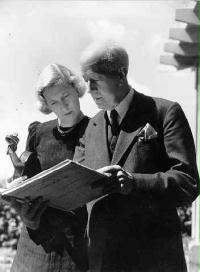|

Edgar Bainton was born in London, the son of a congregational minister, he later moved with his family
to Coventry. He showed early signs of musical ability playing the piano, he was nine years old when he made his first public
appearance as solo pianist. In 1896, he won an open scholarship to the Royal College of Music to study theory with Henry Walford
Davies . In 1899 he received a scholarship to study composition with Sir Charles Villiers Stanford. At college he met and
became friends with George Dyson, William Harris and especially Rutland Boughton, whose friendship and support continued throughout
Bainton's career. Bainton kept a notebook listing nearly all his compositions, the first entry is his first known surviving
work, Prelude and Fugue in B Minor for piano, written in 1898.
In 1901 Bainton became piano professor at the Newcastle upon Tyne Conservatory of Music. He became
involved in the local musical scene, composing, playing and conducting and in 1905, he married a former student, Ethel Eales,
with whom he had two daughters. He became the Principal of the Conservatory in 1912, and acquired property for its expansion.
The family lived in Stocksfield, near Hexham, Bainton would take long country walks, frequently accompanied by Wilfred Gibson,
who introduced Bainton into the literary circle surrounding Gordon Bottomley. Bainton set many of Bottomley's poems and wrote
an opera to one of his lyric dramas. He introduced his local area to previously unknown works by Gustav Holst, Ralph Vaughan
Williams and Arnold Bax amongst others. He developed friendships with poet George Dodds, and cathedral organist, William Ellis.
In the Summer of 1914 Bainton visited Germany to attend the Bayreuth Festival, but was arrested and
interned at Ruhlebena Prisoner-of-war camp, near Berlin, where he remained for the next four years. Bainton was put in charge
of all the music at the camp and became acquainted with Ernest Macmillan and Edward Clark amongst other later successful musicians,
he maintained many of these friendships throughout his career. In March 1918 his health deteriorated and he was sent to The
Hague to recuperate. Following the Armistice, he became the first Englishman to conduct the Amsterdam Concertgebouw Orchestra
in two concerts of British music before returning to England.
Bainton's life returned to normal and he resumed work at the Conservatory. His choral works became
features of the Three Choirs Festivals. Touring Australia and Canada from April 1930 to January 1931, he took a break from
composing, and from August to December 1932 he visited India, giving a piano recital for the Indian Broadcasting Company.
The noted poet and musician Rabindranath Tagore made him a guest in Calcutta and introduced him to Indian music. In 1933,
Sir Edward Bairstow awarded him an honorary Doctor of Music at Durham University.
The New South Wales Conservatorium at Sydney had been impressed by his display of skills in 1930 and
offered him the directorship in the Summer of 1933. Accordingly, in 1934 Bainton and his family started a new life in Australia.
Bainton conducted the choral and orchestral classes at the Conservatorium, and founded the Opera School.
He introduced Australia to new works like Elgar's Symphony No. 2 in 1934 and The Dream of Gerontius in 1936. Coincidently
with Bainton's arrival in Sydney there were moves to form a permanent professional orchestra for the Australian Broadcasting
Commission, New South Wales Symphony Orchestra (later becoming the Sydney Symphony Orchestra), Bainton conducted their inaugural
concert in 1934.
Music previously unheard in Australia was introduced by him, such as Arnold Baxs Third Symphony, works
by Claude Debussy, Jean Sibelius, Frederick Delius, and William Walton amongst others. At the Conservatorium he helped native
Australian composers such as Miriam Hyde, Percy Grainger and Alfred Hill.
At his peak in 1944, the premiere production by the Conservatorium Opera School of Bainton's The Pearl
Tree, received acclaim from the press and public alike. An additional night's performance was given due to demand, at which
a bust of Bainton was unveiled in the foyer. Because of work regulations, Bainton retired aged 65, he continued to conduct
(temporarily with the New Zealand Orchestra), and performed lecture tours in Canada. In 1956, a heart attack severely affected
his health - his wife had died not long beforehand - and on the morning of December 8, he died on the beach at Point Piper,
New South Wales.
|
 |
|

